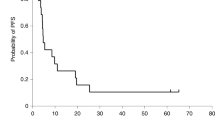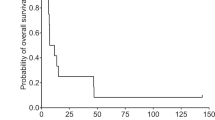Abstract
G207 and NV1020 are two replication-competent, multimutant oncolytic herpes simplex viruses evaluated in the current studies for their anticancer effects in the treatment of gastric cancer. Deletion of both γ134.5 genes and inactivation of ICP6 (ribonucleotide reductase) allows G207 to selectively replicate within tumor cells. NV1020 is another attenuated recombinant herpes virus with deletions of the HSV joint region, with deletion of only one copy of the γ134.5 gene, and with the ICP6 gene intact. In vitro, both G207 and NV1020 effectively infected, replicated, and killed human gastric cancer cells, with NV1020 being more effective at lower concentrations of virus. In a murine xenograft model of peritoneally disseminated gastric cancer, both NV1020 and G207 reduced tumor burden when given intraperitoneally (i.p.) at higher doses. When viral doses were lowered or when advanced tumor was treated, i.p. NV1020 was superior to i.p. G207. In vitro viral replication and cytotoxicity predicted the in vivo antitumor response. Intravenous delivery of either G207 or NV1020 failed to reduce tumor burden, demonstrating the importance of regional therapy as treatment for compartmentalized malignancy. Both agents were safe for use in animals, and immunohistochemistry performed on mouse tissue revealed selective viral targeting of tumor. Oncolytic therapy using genetically engineered HSVs represents a promising strategy for peritoneal malignancies.
This is a preview of subscription content, access via your institution
Access options
Subscribe to this journal
Receive 12 print issues and online access
$259.00 per year
only $21.58 per issue
Buy this article
- Purchase on Springer Link
- Instant access to full article PDF
Prices may be subject to local taxes which are calculated during checkout






Similar content being viewed by others
References
Martuza RL, Malick A, Markert JM, Ruffner KL, Coen DM . Experimental therapy of human glioma by means of a genetically engineered virus mutant Science 1991 252: 854–856
Jia WW, McDermott M, Goldie J, Cynader M, Tan J, Tufaro F . Selective destruction of gliomas in immunocompetent rats by thymidine kinase-defective herpes simplex virus type 1 (see comments) J Natl Cancer Inst 1994 86: 1209–1215
Mineta T, Rabkin SD, Martuza RL . Treatment of malignant gliomas using ganciclovir-hypersensitive, ribonucleotide reductase-deficient herpes simplex viral mutant Cancer Res 1994 54: 3963–3966
Goldstein DJ, Weller SK . Herpes simplex virus type 1-induced ribonucleotide reductase activity is dispensable for virus growth and DNA synthesis: isolation and characterization of an ICP6 lacZ insertion mutant J Virol 1988 62: 196–205
Goldstein DJ, Weller SK . Factor(s) present in herpes simplex virus type 1-infected cells can compensate for the loss of the large subunit of the viral ribonucleotide reductase: characterization of an ICP6 deletion mutant Virology 1988 166: 41–51
Pyles RB, Thompson RL . Evidence that the herpes simplex virus type 1 uracil DNA glycosylase is required for efficient viral replication and latency in the murine nervous system J Virol 1994 68: 4963–4972
Chambers R, Gillespie GY, Soroceanu L et al. Comparison of genetically engineered herpes simplex viruses for the treatment of brain tumors in a scid mouse model of human malignant glioma Proc Natl Acad Sci USA 1995 92: 1411–1415
Andreansky S, Soroceanu L, Flotte ER et al. Evaluation of genetically engineered herpes simplex viruses as oncolytic agents for human malignant brain tumors Cancer Res 1997 57: 1502–1509
Kramm CM, Chase M, Herrlinger U et al. Therapeutic efficiency and safety of a second-generation replication-conditional HSV1 vector for brain tumor gene therapy Hum Gene Ther 1997 8: 2057–2068
Mineta T, Rabkin SD, Yazaki T, Hunter WD, Martuza RL . Attenuated multi-mutated herpes simplex virus-1 for the treatment of malignant gliomas Nat Med 1995 1: 938–943
Pyles RB, Warnick RE, Chalk CL, Szanti BE, Parysek LM . A novel multiply-mutated HSV-1 strain for the treatment of human brain tumors Hum Gene Ther 1997 8: 533–544
Thelander L, Reichard P . Reduction of ribonucleotides Annu Rev Biochem 1979 48: 133–158
Markert JM, Medlock MD, Rabkin SD et al. Conditionally replicating herpes simplex virus mutant, G207 for the treatment of malignant glioma: results of a phase I trial Gene Ther 2000 7: 867–874
Kooby DA, Carew JF, Halterman MW et al. Oncolytic viral therapy for human colorectal cancer and liver metastases using a multimutated herpes simplex virus type-1 (G207) FASEB J 1999 6: 499–504
Bennett JJ, Kooby DA, Delman K et al. Antitumor efficacy of regional oncolytic viral therapy for peritoneally disseminated cancer J Mol Ther 2000 78: 166–174
Walker JR, McGeagh KG, Sundaresan P, Jorgensen TJ, Rabkin SD, Martuza RL . Local and systemic therapy of human prostate adenocarcinoma with the conditionally replicating herpes simplex virus vector G207 Hum Gene Ther 1999 10: 2237–2243
Chahlavi A, Todo T, Martuza RL, Rabkin SD . Replication-competent herpes simplex virus vector G207 and cisplatin combination therapy for head and neck squamous cell carcinoma Neoplasia 1999 1: 162–169
Toda M, Rabkin SD, Martuza RL . Treatment of human breast cancer in a brain metastatic model by G207, a replication-competent multimutated herpes simplex virus 1 Hum Gene Ther 1998 9: 2177–2185
Meignier B, Longnecker R, Roizman B . In vivo behavior of genetically engineered herpes simplex viruses R7017 and R7020: construction and evaluation in rodents J Infect Dis 1999 158: 602–614
Advani SJ, Chung SM, Yan SY et al. Replication-competent, nonneuroinvasive genetically engineered herpes virus is highly effective in the treatment of therapy-resistant experimental human tumors Cancer Res 1999 59: 2055–2058
Delman KA, Bennett JJ, Zager JS et al. Effects of preexisting immunity on the response to herpes simplex-based oncolytic viral therapy Hum Gene Ther 2000 11: 2465–2472
Schipper DL, Wagener DJ . Chemotherapy of gastric cancer Anticancer Drugs 1999 7: 137–149
Kelsen D . Adjuvant and neoadjuvant therapy for gastric cancer Semin Oncol 1999 23: 379–389
Averbach AM, Jacquet P . Strategies to decrease the incidence of intra-abdominal recurrence in resectable gastric cancer Br J Surg 1999 83: 726–733
Yazaki T, Manz HJ, Rabkin SD, Martuza RL . Treatment of human malignant meningiomas by G207, a replication-competent multimutated herpes simplex virus 1 Cancer Res 1995 55: 4752–4756
Meignier B, Martin B, Whitley RJ, Roizman B . In vivo behavior of genetically engineered herpes simplex viruses R7017 and R7020: II. Studies in immunocompetent and immunosuppressed owl monkeys (Aotus trivirgatus) J Infect Dis 1990 162: 313–321
Rosenberg SA, Anderson WF, Blaese M et al. The development of gene therapy for the treatment of cancer Ann Surg 1993 218: 455–463
Yashiro M, Chung YS, Nishimura S, Inoue T, Sowa M . Peritoneal metastatic model for human scirrhous gastric carcinoma in nude mice Clin Exp Metastasis 1999 14: 43–54
Yonemura Y, Yamguchi T, Fujimura T et al. Mechanisms of the formation of the peritoneal dissemination in gastric cancer Gastroenterology 1999 56: 785–802
Ikeda K, Ichikawa T, Wakimoto H et al. Oncolytic virus therapy of multiple tumors in the brain requires suppression of innate and elicited antiviral responses Nat Med 1999 5: 881–887
Kucharczuk JC, Randazzo B, Chang MY et al. Use of a “replication-restricted” herpes virus to treat experimental human malignant mesothelioma Cancer Res 1997 57: 466–471
Yoon SS, Nakamura H, Carroll NM, Bode BP, Chiocca EA, Tanabe KK . An oncolytic herpes simplex virus type 1 selectively destroys diffuse liver metastases from colon carcinoma FASEB J 2000 14: 301–311
Sun WH, Stebler B, Ershler WB . Initial description of a tumor enhancing activity produced by murine splenocytes Biochem Biophys Res Commun 1991 179: 675–682
Roizman B . The function of herpes simplex virus genes: a primer for genetic engineering of novel vectors Proc Natl Acad Sci USA 1996 93: 11307–11312 (Review) (45 refs)
Hamazoe R, Maeta M, Kaibara N . Intraperitoneal thermochemotherapy for prevention of peritoneal recurrence of gastric cancer Cancer 1994 73: 2048–2052
Yu W, Whang I, Suh I, Averbach A, Chang D, Sugarbaker PH . Prospective randomized trial of early postoperative intraperitoneal chemotherapy as an adjuvant to resectable gastric cancer Ann Surg 1998 228: 347–354
Yoon SS, Carroll NM, Chiocca EA, Tanabe KK . Cancer gene therapy using a replication-competent herpes simplex virus type 1 vector Ann Surg 1998 228: 366–374 published erratum appears in Ann Surg 1998:228(5) following table of contents
Danthinne X, Aoki K, Kurachi AL, Nabel GJ, Nabel EG . Combination gene delivery of the cell cycle inhibitor p27 with thymidine kinase enhances prodrug cytotoxicity J Virol 1998 72: 9201–9207
Chou J, Chen JJ, Gross M, Roizman B . Association of a M(r) 90:000 phosphoprotein with protein kinase PKR in cells exhibiting enhanced phosphorylation of translation initiation factor eIF-2 alpha and premature shutoff of protein synthesis after infection with gamma 134.5-mutants of herpes simplex virus 1 Proc Natl Acad Sci USA 1995 92: 10516–10520
He B, Gross M, Roizman B . The gamma(1)34.5 protein of herpes simplex virus 1 complexes with protein phosphatase 1alpha to dephosphorylate the alpha subunit of the eukaryotic translation initiation factor 2 and preclude the shutoff of protein synthesis by double-stranded RNA-activated protein kinase Proc Natl Acad Sci USA 1997 94: 843–848
Chou J, Roizman B . The gamma 1(34.5) gene of herpes simplex virus 1 precludes neuroblastoma cells from triggering total shutoff of protein synthesis characteristic of programmed cell death in neuronal cells Proc Natl Acad Sci USA 1992 89: 3266–3270
Chou J, Kern ER, Whitley RJ, Roizman B . Mapping of herpes simplex virus-1 neurovirulence to gamma 134.5, a gene nonessential for growth in culture Science 1990 250: 1262–1266
Leib DA, Machalek MA, Williams BR, Silverman RH, Virgin HW . Specific phenotypic restoration of an attenuated virus by knockout of a host resistance gene Proc Natl Acad Sci USA 2000 97: 6097–6101
Hunter WD, Martuza RL, Feigenbaum F et al. Attenuated, replication-competent herpes simplex virus type 1 mutant G207: safety evaluation of intracerebral injection in nonhuman primates J Virol 1999 73: 6319–6326
Poffenberger KL, Tabares E, Roizman B . Characterization of a viable, noninverting herpes simplex virus 1 genome derived by insertion and deletion of sequences at the junction of components L and S Proc Natl Acad Sci USA 1983 80: 2690–2694
Suzuki T, Yanagi K, Ookawa K, Hatakeyama K, Ohshima N . Blood flow and leukocyte adhesiveness are reduced in the microcirculation of a peritoneal disseminated colon carcinoma Ann Biomed Eng 1998 26: 803–811
Acknowledgements
This work was supported in part by Grants RO1 CA 76416, RO1 CA 72632, and RO1 RO1CA/DK80982 (YF) from the National Institutes of Health, Grant MBC-99366 (YF) from the American Cancer Society, and a grant from the Lustgarten Foundation.
Author information
Authors and Affiliations
Corresponding author
Rights and permissions
About this article
Cite this article
Bennett, J., Delman, K., Burt, B. et al. Comparison of safety, delivery, and efficacy of two oncolytic herpes viruses (G207 and NV1020) for peritoneal cancer. Cancer Gene Ther 9, 935–945 (2002). https://doi.org/10.1038/sj.cgt.7700510
Received:
Published:
Issue Date:
DOI: https://doi.org/10.1038/sj.cgt.7700510
Keywords
This article is cited by
-
Application of interferon modulators to overcome partial resistance of human ovarian cancers to VSV-GP oncolytic viral therapy
Molecular Therapy - Oncolytics (2016)
-
Use of miRNA Response Sequences to Block Off-target Replication and Increase the Safety of an Unattenuated, Glioblastoma-targeted Oncolytic HSV
Molecular Therapy (2015)
-
Treatment of human hepatocellular carcinoma by the oncolytic herpes simplex virus G47delta
Cancer Cell International (2014)
-
Immunogenic HSV-mediated Oncolysis Shapes the Antitumor Immune Response and Contributes to Therapeutic Efficacy
Molecular Therapy (2014)
-
A Rationally Designed A34R Mutant Oncolytic Poxvirus: Improved Efficacy in Peritoneal Carcinomatosis
Molecular Therapy (2013)



